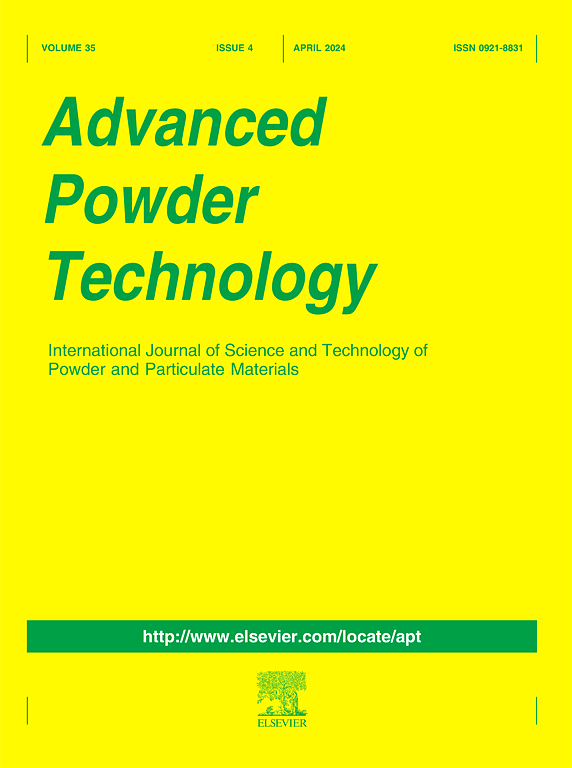Optimization of graphite anode delamination and contaminant separation via electrical pulsed discharge for direct recycling
IF 4.2
2区 工程技术
Q2 ENGINEERING, CHEMICAL
引用次数: 0
Abstract
This study investigated the direct recycling of graphite anode materials from spent lithium-ion batteries using electrical pulsed discharge (EPD). High-speed imaging showed that direct arc discharge into copper (Cu) foil enabled the efficient delamination of graphite through vapor bubble expansion and shock wave generation. The optimization of sample positioning and discharge pulses influences the discharge behavior, separation efficiency, and material integrity of the samples. Under optimized conditions, over 95% delamination was achieved while maintaining graphite structural integrity, confirmed by XRD, TG-DTA, Raman spectroscopy, and direct observations from optical microscopy and SEM images. ICP-OES and SEM-EDS analyses revealed iron and Cu contaminants from electrode erosion and the anode’s Cu foil. The Cu particles exhibited two morphologies: foil-like fragments from mechanical detachment and spherical particles from arc-induced melting. Post-EPD separation methods, including wet sieving, elutriation, and acid leaching, were evaluated for contaminant removal from the concentrates. Wet sieving isolated low-contamination fractions, whereas elutriation recovered high-purity graphite fractions. Acid leaching reduced the Cu concentrations, particularly in the fine fractions containing porous spherical Cu particles. The results show that the optimized EPD conditions, strategic positioning, and sequential separation processes enable the recovery of intact, high-purity graphite for the direct recycling of spent anodes.
[Keywords]
Lithium-ion batteries; Contaminant separation; Recycling; Structural integrity; Elutriation.

电脉冲放电直接回收石墨阳极分层及污染物分离的优化
研究了利用脉冲放电(EPD)直接回收废旧锂离子电池中的石墨负极材料。高速成像表明,直接电弧放电到铜箔中,通过气泡膨胀和激波产生,使石墨有效地分层。样品定位和放电脉冲的优化影响着样品的放电行为、分离效率和材料完整性。通过XRD、TG-DTA、拉曼光谱以及直接观察光学显微镜和扫描电镜图像证实,在优化条件下,在保持石墨结构完整性的同时,实现了95%以上的脱层。ICP-OES和SEM-EDS分析显示电极侵蚀和阳极的铜箔中含有铁和铜污染物。铜颗粒表现出两种形态:机械分离产生的箔状碎片和电弧熔化产生的球形颗粒。后epd分离方法,包括湿筛,洗脱和酸浸,评估了从精矿中去除污染物。湿法筛分分离出低污染组分,而淋洗法回收出高纯度石墨组分。酸浸降低了铜的浓度,特别是在含有多孔球形铜颗粒的细馏分中。结果表明,优化的EPD条件、战略定位和顺序分离工艺可以回收完整的高纯度石墨,用于废阳极的直接回收。[关键词]锂离子电池;污染物分离;回收;结构完整性;淘洗。
本文章由计算机程序翻译,如有差异,请以英文原文为准。
求助全文
约1分钟内获得全文
求助全文
来源期刊

Advanced Powder Technology
工程技术-工程:化工
CiteScore
9.50
自引率
7.70%
发文量
424
审稿时长
55 days
期刊介绍:
The aim of Advanced Powder Technology is to meet the demand for an international journal that integrates all aspects of science and technology research on powder and particulate materials. The journal fulfills this purpose by publishing original research papers, rapid communications, reviews, and translated articles by prominent researchers worldwide.
The editorial work of Advanced Powder Technology, which was founded as the International Journal of the Society of Powder Technology, Japan, is now shared by distinguished board members, who operate in a unique framework designed to respond to the increasing global demand for articles on not only powder and particles, but also on various materials produced from them.
Advanced Powder Technology covers various areas, but a discussion of powder and particles is required in articles. Topics include: Production of powder and particulate materials in gases and liquids(nanoparticles, fine ceramics, pharmaceuticals, novel functional materials, etc.); Aerosol and colloidal processing; Powder and particle characterization; Dynamics and phenomena; Calculation and simulation (CFD, DEM, Monte Carlo method, population balance, etc.); Measurement and control of powder processes; Particle modification; Comminution; Powder handling and operations (storage, transport, granulation, separation, fluidization, etc.)
 求助内容:
求助内容: 应助结果提醒方式:
应助结果提醒方式:


